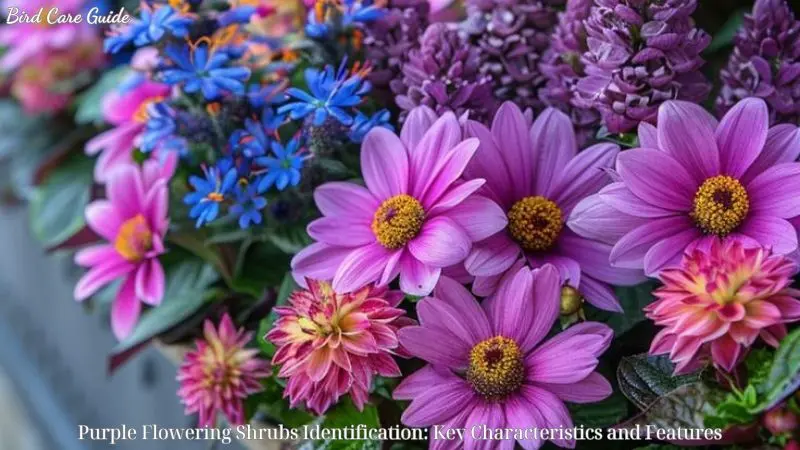Purple Flowering Shrubs Identification can be a delightful endeavor for gardeners, botanists, and nature enthusiasts. These shrubs add a burst of color to gardens and landscapes, making them highly desirable for aesthetic and ecological purposes. This “Bird Care Guide” delves into the key characteristics and features of many purple shrubs, providing comprehensive information to aid in their identification.
Understanding Shrub Characteristics
Before delving into specific purple flowering shrubs, it is essential to understand the general characteristics that define shrubs and how they differ from other plant forms.
What is a Shrub?
A shrub is a woody plant that typically has multiple stems and is shorter than a tree. Shrubs can vary in height, ranging from low-growing ground covers to taller specimens that may reach several meters. They can be deciduous, losing their leaves in the winter, or evergreen, retaining their foliage year-round.
Key Identifying Features of Shrubs
To identify shrubs, consider the following key features:
- Leaves: Shape, size, arrangement (opposite, alternate, or whorled), margin (smooth, serrated, or lobed), and color.
- Flowers: Color, shape, size, arrangement (clustered, solitary, or in spikes/panicles), and blooming season.
- Bark: Color, texture (smooth, peeling, or ridged), and pattern.
- Fruit: Type (berry, capsule, drupe, or nut), color, and season of maturity.
Key Characteristics for Identifying Purple Flowering Shrubs
Flower Color and Shape
- Flower Color: The most obvious characteristic is the purple hue of the flowers, which can range from light lavender to deep violet. Variations in shade can help distinguish between different species.
- Flower Shape: The shape of the flowers can be tubular, bell-shaped, or clustered. This is a crucial feature for identification as different species exhibit distinct floral structures.
Leaf Arrangement and Shape
- Leaf Arrangement: Leaves can be arranged alternately, oppositely, or in whorls along the stem. Observing the pattern of leaf attachment is vital for identification.
- Leaf Shape: Leaves may be oval, lanceolate, or lobed. The margins of the leaves can be smooth, serrated, or wavy, providing additional clues.
Growth Habit
- Shrub Size: Purple flowering shrubs vary in size, from compact, low-growing types to tall, sprawling bushes. Identifying the growth habit helps narrow down the possibilities.
- Branching Pattern: The way branches spread—whether upright, arching, or cascading—also aids in identification.
Blooming Season
- Blooming Period: Knowing when a shrub typically blooms can be a significant identifier. Some shrubs flower in early spring, while others may bloom in summer or fall.
Habitat and Soil Preferences
- Natural Habitat: Identifying the native habitat of a shrub, such as woodland, meadow, or garden, can provide context for identification.
- Soil Preferences: Different shrubs have varying soil requirements, such as acidic, alkaline, sandy, or clay soils.
Purple flowering shrubs identification popular

1. Lilac (Syringa vulgaris)
Description: Lilacs are among the most well-known purple flowering shrubs. They are cherished for their fragrant blooms and classic beauty.
- Flower Color: Pale to deep purple
- Flower Shape: Panicles of small, tubular flowers
- Leaf Arrangement: Opposite
- Leaf Shape: Heart-shaped with smooth margins
- Growth Habit: Upright and multi-stemmed, growing up to 15 feet
- Blooming Season: Late spring
- Habitat and Soil Preferences: Prefers well-drained, alkaline soil and full sun
Key Identification Features: The heart-shaped leaves and fragrant, tubular flowers in large panicles are distinguishing characteristics of lilacs.
2. Butterfly Bush (Buddleja davidii)
Description: The Butterfly Bush is named for its ability to attract butterflies. It is a fast-growing shrub that produces long, arching clusters of flowers.
- Flower Color: Purple, lavender, or white
- Flower Shape: Dense, cone-shaped clusters
- Leaf Arrangement: Opposite
- Leaf Shape: Lanceolate with serrated margins
- Growth Habit: Arching branches, growing up to 10 feet
- Blooming Season: Summer to early fall
- Habitat and Soil Preferences: Thrives in well-drained soil and full sun
Key Identification Features: The long, cone-shaped flower clusters and lanceolate leaves are distinctive markers of the Butterfly Bush.
3. Rhododendron (Rhododendron spp.)
Description: Rhododendrons are evergreen or deciduous shrubs known for their large, showy blooms.
- Flower Color: Purple, pink, red, white
- Flower Shape: Bell-shaped or funnel-shaped
- Leaf Arrangement: Spiral or alternate
- Leaf Shape: Oval to lanceolate with smooth or slightly serrated margins
- Growth Habit: Dense, bushy, growing up to 20 feet
- Blooming Season: Late spring to early summer
- Habitat and Soil Preferences: Prefers acidic, well-drained soil and partial shade
Key Identification Features: The large, bell-shaped flowers and the preference for acidic soil are characteristic of Rhododendrons.
4. Hydrangea (Hydrangea macrophylla)
Description: Hydrangeas are beloved for their large, globe-like clusters of flowers that can change color based on soil pH.
- Flower Color: Purple, blue, pink, or white
- Flower Shape: Mophead or lacecap clusters
- Leaf Arrangement: Opposite
- Leaf Shape: Oval with serrated margins
- Growth Habit: Rounded, growing up to 6 feet
- Blooming Season: Summer to early fall
- Habitat and Soil Preferences: Prefers moist, well-drained soil and partial shade
Key Identification Features: The large, spherical flower clusters and the ability to change flower color based on soil pH are unique to Hydrangeas.
5. Clematis (Clematis spp.)
Description: Clematis are climbing shrubs known for their stunning, star-shaped flowers.
- Flower Color: Purple, pink, blue, white
- Flower Shape: Star-shaped or bell-shaped
- Leaf Arrangement: Opposite
- Leaf Shape: Compound with oval leaflets
- Growth Habit: Climbing or trailing, growing up to 15 feet
- Blooming Season: Varies by species; spring to fall
- Habitat and Soil Preferences: Prefers well-drained soil and full sun to partial shade
Key Identification Features: The climbing habit and star-shaped flowers make Clematis easily identifiable.
6. Heather (Calluna vulgaris)
Description: Heather is a low-growing, evergreen shrub with delicate, bell-shaped flowers.
- Flower Color: Purple, pink, white
- Flower Shape: Bell-shaped
- Leaf Arrangement: Opposite
- Leaf Shape: Small, scale-like leaves
- Growth Habit: Compact, mat-forming, growing up to 2 feet
- Blooming Season: Late summer to early fall
- Habitat and Soil Preferences: Prefers acidic, well-drained soil and full sun
Key Identification Features: The mat-forming growth habit and small, bell-shaped flowers are characteristic of Heather.
7. Azalea (Rhododendron spp.)
Description: Azaleas, a type of Rhododendron, are known for their vibrant, trumpet-shaped flowers.
- Flower Color: Purple, pink, red, white
- Flower Shape: Trumpet-shaped
- Leaf Arrangement: Alternate or spiral
- Leaf Shape: Oval with smooth margins
- Growth Habit: Bushy, growing up to 10 feet
- Blooming Season: Spring
- Habitat and Soil Preferences: Prefers acidic, well-drained soil and partial shade
Key Identification Features: The trumpet-shaped flowers and preference for acidic soil are distinctive features of Azaleas.
Practical Tips for Identifying Purple Flowering Shrubs
- Observe the Flowers: Note the color, shape, and arrangement of the flowers. Take note of any variations in shade and pattern.
- Examine the Leaves: Look at the arrangement, shape, and margins of the leaves. Compare them with known species.
- Assess the Growth Habit: Consider the overall shape and size of the shrub. Note whether it is upright, sprawling, or climbing.
- Check the Blooming Season: Identify the time of year the shrub blooms. Different species have distinct flowering periods.
- Consider the Habitat: Take into account the natural or cultivated habitat of the shrub. Soil type and light conditions can be indicative.
Benefits of Purple Flowering Shrubs
Purple flowering shrubs offer numerous benefits beyond their aesthetic appeal. Here are some of the advantages of incorporating these shrubs into your garden:
Aesthetic Value
- Visual Appeal: The vibrant purple flowers add striking color to gardens and landscapes, creating focal points and enhancing overall beauty.
- Variety: With a wide range of species and cultivars, gardeners can choose shrubs that suit their design preferences and climate conditions.
Wildlife Attraction
- Pollinators: Many purple flowering shrubs attract pollinators such as bees, butterflies, and hummingbirds, supporting biodiversity and ecological health.
- Birds and Small Mammals: Some shrubs produce berries and seeds that provide food for birds and small mammals.
Environmental Benefits
- Erosion Control: Shrubs with extensive root systems help stabilize soil and prevent erosion on slopes and embankments.
- Air Quality: Shrubs absorb carbon dioxide and release oxygen, contributing to cleaner air.
Maintenance and Care of Purple Flowering Shrubs
Proper maintenance and care are crucial for the health and vitality of purple flowering shrubs. Here are some essential tips to ensure your shrubs thrive:
Planting
- Location: Choose a location that matches the sunlight and soil preferences of the specific shrub. Most purple flowering shrubs prefer full sun to partial shade.
- Soil Preparation: Prepare the soil by adding organic matter such as compost or well-rotted manure. Ensure good drainage to prevent root rot.
- Planting Depth: Plant the shrub at the same depth as it was in the nursery pot. Water thoroughly after planting to settle the soil around the roots.
Watering
- Regular Watering: Newly planted shrubs need consistent moisture to establish roots. Water deeply and regularly, especially during dry spells.
- Mulching: Apply a layer of mulch around the base of the shrub to conserve moisture, suppress weeds, and regulate soil temperature.
Pruning
- Timing: Prune flowering shrubs after they have finished blooming. For spring-blooming shrubs, prune in late spring or early summer. For summer-blooming shrubs, prune in late winter or early spring.
- Techniques: Remove dead, damaged, or diseased branches. Thin out crowded areas to improve air circulation and light penetration. Shape the shrub to maintain its form and size.
Fertilizing
- Balanced Fertilizer: Use a balanced, slow-release fertilizer in early spring to provide essential nutrients. Avoid excessive nitrogen, which can promote leaf growth at the expense of flowers.
- Organic Options: Consider organic fertilizers such as compost, fish emulsion, or bone meal for a more natural approach.
Pest and Disease Management
- Regular Inspections: Check your shrubs regularly for signs of pests and diseases. Early detection can prevent serious problems.
- Common Pests: Aphids, spider mites, and scale insects are common pests. Use insecticidal soap, neem oil, or horticultural oil to control infestations.
- Diseases: Fungal diseases such as powdery mildew and root rot can affect purple flowering shrubs. Ensure good air circulation and proper watering practices to minimize risks.
Conclude
Identifying purple flowering shrubs is a rewarding endeavor that enhances one’s appreciation of the natural world. By paying attention to key characteristics and understanding the unique features of each species, gardeners and nature enthusiasts can successfully identify and cultivate these beautiful shrubs.





